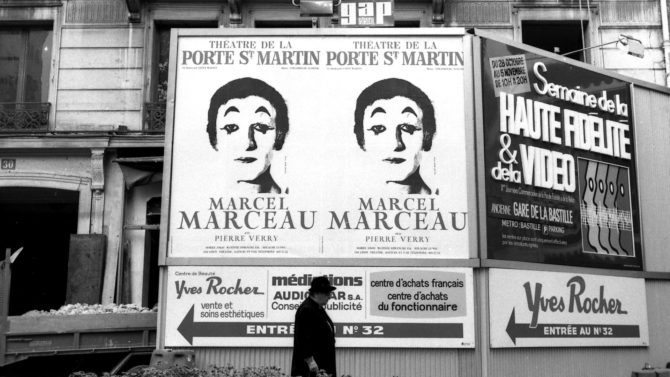French Icon: How Marcel Marceau mastered mime and joined the resistance
The language of mime does not speak through words but through the heart,” Marcel Marceau says in a video for Encyclopædia Britannica, in which he explains how his chosen art form can reveal humanity’s deepest feelings and aspirations, and connect with people across all nations and all races.
Influenced in his youth by silent movies and his experiences in World War II, Marceau’s belief in the power of performance made him a legend of mime.
Becoming Bip
Marceau was 22 when he created his alter-ego Bip – named after Pip, the main character in Charles Dickens’ Great Expectations. Bip wore a striped top, a crumpled top hat with a flower in it, and a white face emulating that of the 19th-century commedia dell’arte character Pierrot. However, Marceau’s performance style was contemporary for the time and was inspired by slapstick screen stars such as Charlie Chaplin and Laurel and Hardy. The character went on many adventures through numerous pantomimes de Bip that Marceau created; he travelled by train, caught butterflies, tamed a lion, visited a dating service, and more. Marceau also created and performed several Bip-free pantomimes de style which further combined comedy and tragedy, exploring the struggles of life in a clownish manner.
The artist learnt his craft from another mime master, Étienne Decroux, a Parisian actor who developed a particular method of physical theatre – corporeal mime. In 1947, Marceau founded his own mime company, and later in life he set up a school to teach a whole new generation of mime artists. The École Internationale de Mimodrame de Paris Marcel Marceau was founded in 1978 and closed in 2005, two years before his death aged 84.
Joining the Resistance
Before he became the mime we know, the performer’s younger years were very much shaped by World War II and the French Resistance. Part of a Jewish family with the name Mangel – his father was a kosher butcher who sadly did not survive the war – Marcel grew up in Strasbourg, a city on the border with Germany, until the age of 16 when the war broke out and he was sent to the province of Périgord, where the département of Dordogne is now located, in Nouvelle-Aquitaine.
He spent some time being hidden by his cousin Georges Loinger and other members of the Resistance. In turn, he and his brother Alain did their bit for the fight, forging identity cards and papers, and helping children escape across the border to Switzerland. It was on his own forged documents that he first took the name Marceau. At the end of the war, one of his first big stage performances was to 3,000 American soldiers.
Star of stage and screen
In the years that followed Marceau’s career flourished. He spent a short time with the Renaud-Barrault theatre company but was destined to shine as a solo performer. From the late 1940s he performed in theatres around the world including many shows in the United States where he touched the hearts and tickled the ribs of audience after audience. Later he also starred in some short films including Un Jardin Public, directed by Paul Paviot in 1955. His notability grew and his love of film continued. In 1968 he took a speaking role as Professor Ping in sci-fi film Barbarella starring Jane Fonda and in 1976 he made a cameo in the comedy Silent Movie.
At home in France, the mime extraordinaire was honoured with a Légion d’Honneur and election to the Académie des Beaux-Arts.
Share to: Facebook Twitter LinkedIn Email
More in France Magazine, French Film, French history, french icon




